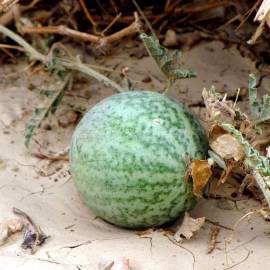







«Bitter Apple» - Citrullus colocynthis Seeds
1.39 €
Citrullus colocynthis, also known as bitter cucumber, is a fruit-bearing plant sometimes used medicinally, citrullus colocynthis is used to treat diabetes, since it may be able to induce insulin secretion from the pancreas after supplementation.
-
Citrullus colocynthis (Bitter Apple)
Citrullus colocynthis, also known as bitter cucumber or bitter apple, is a fruit-bearing plant sometimes used medicinally.
Citrullus colocynthis is used to treat diabetes, since it may be able to induce insulin secretion from the pancreas after supplementation, while reducing blood glucose and improving lipid levels. Preliminary evidence suggests a topical application of Citrullus colocynthis may stimulate hair growth, with an effect comparable to finasteride, a male pattern baldness drug. More evidence is needed to confirm this effect.
Even low doses (100mg, taken three times) of Citrullus colocynthis can cause diarrhea, while higher doses (1,500 mg) can cause colonic inflammation and rectal bleeding. These side-effects stop once supplementation is ceased. Since the bioactive compounds in Citrullus colocynthis are still unknown, and even low-dose supplementation is associated with intestinal side-effects, Citrullus colocynthis is not recommended for oral supplementation.
Germination
In cool climates, watermelon seeds should be started indoors, but no sooner than a month before transplanting; plant three seeds per peat pot, 1/4" deep. Provide heat to keep the soil at least 80-85 degrees F. Cut off all but the strongest seedling as soon as true leaves appear, and transplant about a week after frost; put two or three plants in each hill with a 6-8' space in all directions. Gardeners in warm climates will be able to direct sow watermelons as soon as the soil temperature reaches at least 75 degrees F, planting six seeds per hill with 6-8' of space in all directions. Thin to the strongest two or three plants as soon as the seedlings appear. Watermelons should be planted in full sun and rich, loose soil. Young seedlings may benefit from black plastic to warm up the soil.
Growing Seeds
As soon as the vines begin to develop, apply a thick layer of mulch to control weeds and protect the melons from soil contact. Keep the soil moist until the fruit begins to grow, then water only if the soil dries out completely. Watch out for insect pests, which can be a problem. Charleston Grey is resistant to anthracnose and fusarium wilt.
Harvesting
Gardeners use many different methods of testing whether their watermelons are ripe, but knowing the approximate mature size of the melon helps to determine when it is nearing ripeness. One test is to knock on the watermelon with your knuckles, listening for a dull thump rather than a hollow ring. Another method is to check the underside of the melon where it rests on the ground; the skin should be a rich yellow. Also, the curling tendril closest to the stem of the melon often indicates ripeness when it begins to turn brown. Watermelons usually keep for several weeks in a cool place.
